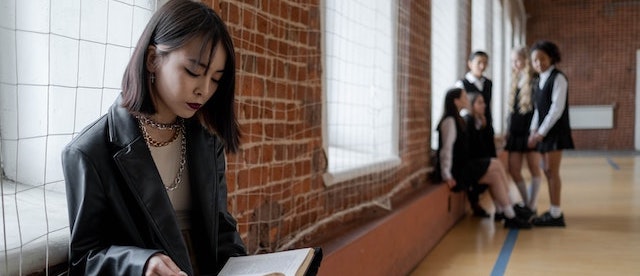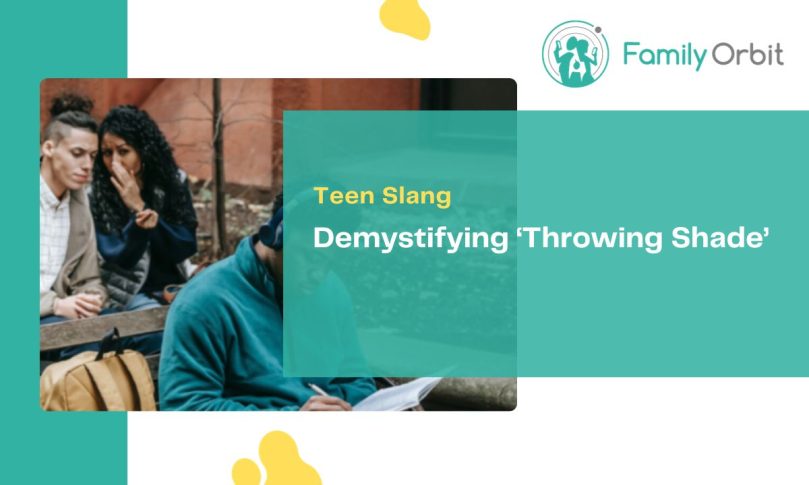It’s possible that you’ve already heard the term “throwing shade” from your teens while they were chatting with friends. Or maybe you’ve seen them use it while reading comments online. The phrase is common in social media and pop culture, but what does it actually mean?
Is it a positive or negative phrase that your teens should freely use? Is it something you should be concerned about? Here we have all the answers to explain everything you need to know about the term throwing shade.
Demystifying ‘Throwing Shade: The Teen Slang Puzzle
Throwing shade is a slang term that is usually a subtle, sarcastic, and indirect insult/criticism towards another person. It shows disapproval over something or a way to mock someone in a discreet manner since it appears clever or humorous.
You will often hear it in casual conversations, specifically among teens. For example, if someone has written a negative social media post about another person, someone may say they are throwing shade at that person.
Teen Lingo Unveiled: Understanding ‘Throwing Shade’ and Its Usage
Teens often use the term in the online world, but they also use it in real-life scenarios. Throwing shade means to dismiss, belittle, disapprove of something, insult, or even degrade something verbally or nonverbally.
So if you see or hear this phrase being used by your teen, it can mean any of those things we mentioned. It can be hard to understand this term as there are many different ways to “throw shade”.
It is also a subjective way to express words or actions in a negative sense. Plus, it has solid moral grounds or is a form of outrage. Simply put, throwing shade is when someone is expressing a negative opinion of someone else.
This could be verbal, such as criticizing someone to your friends, or it can be non-verbal, such as ignoring someone you think has wronged you. This is why understanding the context of throwing shade can be vitally important.
Light and Shadow: Where Teens Use Throwing Shade

Teens often use the term on social media platforms like Twitter, Facebook, etc. It’s used when mocking or criticizing someone indirectly with the use of sarcastic, indirect comments.
Throwing shades has ended up as part of modern slang and is also sometimes used in real life when communicating with others.
The Art of Subtlety: Different Ways ‘Throwing Shade’ Takes Form
Throwing shade is an effective response that can be thrown at someone nonverbally or verbally, and it works all the time no matter the reception. That means, it doesn’t matter if the receiver of the term acknowledges it or not, as long as it gets off someone’s chest.
The verbal method of throwing shade is straightforward since it involves words, making it easier to understand. People use verbal language to express their emotions, and this can be in person, over the phone, or online.
Nonverbal methods of throwing shade include using facial expressions and bodily gestures. Examples include eye-rolls and physical movements that convey disrespect, such as not acknowledging someone. Unlike verbal shade, non-verbal is more challenging to observe and comprehend.
Why Teens Love ‘Throwing Shade’: Insights into Its Appeal
Saying someone is throwing shade has become a humorous way to highlight the negative behavior of others. This is due to the fact it’s said by third parties who don’t have direct involvement in the conflict and are instead watching from afar.
Teens, like most people, find fun in negative humor. It’s all fun and games as long as it’s done harmlessly and doesn’t end up as emotional bullying. Subtle disrespect is fine and can be enjoyable as long as the involved individuals understand each other.
Most times the use of this term is harmless. For example, your teen may say it in a conversation with their friends when referencing a feud between two celebrities. Often they’ll use it in situations that they have no involvement in.
Parental Insight: Grasping the Nuances of ‘Throwing Shade’

The term “throwing shade” is a modern slang. However, the act of making subtle sarcastic remarks, criticisms, or insults is innate in human psychology. While it’s not necessarily bad or harmful, it’s not also good.
In this context, “shade” can sometimes be a good backlash for shady conversations, but can end up being hurtful. It’s important to look at the overall context of the conversation before you get worried that they are involved in a dispute.
For example, they may say “Did you see [celebrity #1] was throwing shade at [celebrity #2] today? I love the drama”. Here the context is harmless as it’s something they aren’t involved with. They may also be talking about an incident at school that they’re not a part of.
However, if they say “Becky was throwing shade at me today and it’s really getting me down” then that’s more a cause for concern. Before deciding whether or not you should be concerned, it’s always important to appreciate the wider context.
Opening the Lines of Communication: Talking to Your Teen About Slang
Most teenagers know the meaning of the slang “throwing shade” and even know how to do it. Some shade remarks they make are also creative and clever, but some can be hurtful despite the insult being subtle.
As parents, you may be concerned about your kids’ behavior as they continue to get exposed to slang like “throwing shade”. Instead of immediately thinking the worst, it’s vital to have an open-minded chat with them to ensure they aren’t in any emotional distress.
It seems like teens have new words and terms every day, and many of them use these in online conversations. With enough research and communication with your children, you can easily navigate and understand the slang used by teens in this digital age.
That can be helped with a parental control app with helps to ensure your kids are staying safe online. These apps can help you monitor their chats and track their location to help you keep them safe.
While these apps can be hugely useful, open communication is always vital to understanding your children and what they are going through.
- Monitor Calls & Text Messages
- View Photos and Videos
- Location Tracking & Geofence
- Monitor WhatsApp & Kik
- Detect & Alert for Inappropriate Activities
- Monitor Websites Visited
- Compatible with Android and iOS
- 200+ Teen Slang Terms Decoded for Parents: Unlocking the Teen Lexicon
- 143 Meaning: Decoding the Numeric Expression of Love
- FOMO Meaning in Text: Decoding Teen FOMO
- AFK Explained: Understanding the Gaming Slang
- ASL Meaning in Text: Unveiling the Significance of ‘ASL’ Slang
- What Does BTW Mean: A Parent’s Guide
- What Does TBH Mean: Decoding Teen Communication

